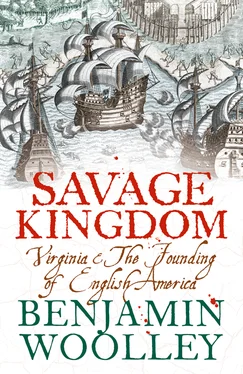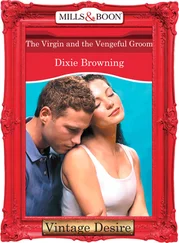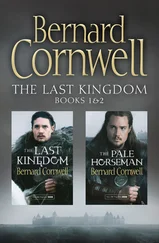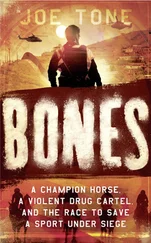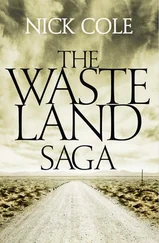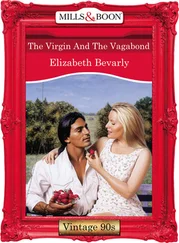Smith faced formidable obstacles. Few men were in a fit state to accompany him, they were all inadequately equipped, none was proficient in the local language, and Smith lacked the skills of a mariner to sail the shallop. But, ever willing to confront overwhelming difficulties with confident resolve, he set off downriver, heading for Kecoughtan, at the mouth of the James.
His reception by the people of Kecoughtan was very different from the one received by Newport when the fleet first arrived. As his boat approached the shore, Smith claimed he was ‘scorned’ like a ‘famished man’, the Indians offering him ‘in derision … a handful of corn, a piece of bread for their swords and muskets, and suchlike proportions also for their apparel’. In typically boisterous style, Smith drove the boat on to the beach, and ordered his men to ‘let fly’ their muskets, even though he knew this was ‘contrary to his commission,’ as set out in the Royal Council’s instructions. The Kecoughtans melted away into the woods.
Smith headed towards the village, passing what he claimed to be ‘great heaps of corn’, recently harvested from the surrounding fields. Then he heard a ‘most hideous noise’. Sixty or seventy villagers, ‘some black, some red, some white, some parti-coloured, came in a square order, singing and dancing out of the woods’. They carried before them what Smith saw as a diabolical doll ‘which was an idol made of skins stuffed with moss, all painted and hung with chains and copper’. Smith thought it was Okeus, the most powerful god of the Powhatan pantheon, who another English observer noted could look ‘into all men’s actions and, examining the same according to the severe scale of justice, punisheth them with sicknesses, beats them, and strikes their ripe corn with blastings, storms, and thunderclaps, stirs up war, and makes their women false unto them’. 24 If it was Okeus, his appearance in such a manner, before the Otasantasuwak, the wearer of leg coverings, was unprecedented. This god, the English were later told, had prophesied their coming to Virginia, and his appearance now must have been designed to stage a momentous confrontation: to frighten the invaders off, perhaps, or possibly the opposite: to lure them in, integrate them into the Powhatan world, to see what havoc they would wreak.
Smith at this moment had little interest in spiritual speculations, and ordered his men to attack the oncoming parade ‘with their muskets loaden with pistol shot’ until ‘down fell their god, and divers lay sprawling on the ground’. Smith snatched the idol, and the Indians disappeared into the woods. Presently, a priest approached offering peace for the return of the okee . Smith told them if six of them came unarmed and loaded his boat, he would ‘not only be their friend, but restore them their okee , and give them beads, copper’. This the Kecoughtans did, according to Smith, loading his boat with venison, turkeys, wildfowl and corn, while ‘singing and dancing in sign of friendship’. 25
Smith set off back for Jamestown, congratulating himself that his more robust approach to Indian relations was already paying dividends. En route, he stopped off at Warraskoyack, a few miles upstream of Kecoughtan, on the opposite bank of the river. There he managed to extract some more corn, a total, he claimed, of thirty bushels, getting on for a ton.
Back at the fort, he distributed the corn, but found that the thanks and appreciation he felt he deserved were muffled by the ravenous stuffing of mouths.
In any case, this was no long-term solution. Thirty bushels of corn would feed forty or so men for four or five days. With barely two weeks’ worth of food left of the store brought from England, a more drastic solution was called for.
According to Smith, Ratcliffe suggested that he take the pinnace back to England ‘to procure a supply’. Memories were still fresh of Ratcliffe’s proposal that the fleet return home even as it was on the threshold of Chesapeake Bay, and to Smith this new idea suggested some darker design, perhaps to deprive the colony of its only means of escape. After the inevitable bout of violent argument, it was agreed that instead the pinnace and shallop should be taken upriver to the falls, in the hope that sufficient supplies could be extracted, violently or otherwise, from the Indian villages sitting among those fertile lands. ‘Lots were cast’ to decide who would command the expedition, and the lots somehow contrived to make the obvious selection of Smith.
The mariners set about rigging the pinnace, an operation that would take a few days, as the ship’s masts and sails had been stowed in the fort to prevent it being taken. Meanwhile, Smith continued his search for food. He set off in the shallop for Quiyoughcohannock. He found the village abandoned, except for ‘certain women and children who fled from their houses’. ‘Corn they had plenty,’ Smith observed, but he had no commission to ‘spoil’ or loot, so he left the village unmolested. On the return journey to Jamestown, he visited Paspahegh. With the English settlement now so firmly entrenched on their land, relations with these people were still bad. Smith described them as ‘churlish and treacherous’, and accused them of trying to steal English weapons as he traded for ten bushels of corn.
The pinnace was now ready for the expedition to the falls, and, arranging to rendezvous with the ship by the next tide at Point Weanock, Smith set off in the shallop to explore the Chickahominy, the tributary of the James.
He left Jamestown on the morning of 9 November, and reached Paspahegh, at the confluence of the James and Chickahominy, that afternoon. The tide was low, so the captain and his company of eight or so men waited at the Indian village. As evening approached, an Indian from one of the villages along the Chickahominy came to Paspahegh and offered to guide the English up the river. The Paspaheghans ‘grudged thereat’. Smith, observing an opportunity to snub his ungrateful hosts, accepted the invitation. By the light of the moon, he took the shallop up the Chickahominy, reaching Menascosic, his guide’s village, by midnight. ‘The next morning,’ Smith records, ‘I went up to the town and showed them what copper and hatchets they should have for corn, each family seeking to give me most content.’
According to Smith, the people of Menascosic would have sold him all the corn he wanted, but ‘lest they should perceive my too great want’, he refused further offers, and continued upriver looking for other people to trade with, passing along the way a grove of plane trees ‘watered with many springs’, and ‘a great marsh of 4 or 5 miles circuit, divided in 2 islands by the parting of the river, abounding with fish and fowl of all sorts’. Further on he discovered a series of villages, ‘at each place kindly used, especially at the last’, which was Mamanahunt, ‘being the heart of the country, where were assembled 200 people with such abundance of corn as having laded our barge as also I might have laded a ship’. Smith triumphantly set off back to Jamestown, his sojourn vindicated by seven hogsheads of food, equivalent to nearly fifty bushels, at least a week’s supply.
The shallop arrived at Jamestown in the middle of the night. As it slipped through the water of the river towards the flickering beacon of the fort’s night watch, Smith noticed something odd. The pinnace, which should have used the high tide to sail upstream for the intended rendezvous, was marooned on a sandbank near the fort. 26
The sun rose the following morning upon a settlement once more in the throes of mutiny. Having managed to ‘strengthen’ himself with the ship’s crew, Kendall had hijacked the pinnace, and set sail for Spain, in order to reveal to King Philip ‘all about this country and many plans of the English which he knew’. He was somehow prevented, incompetent navigation or the crew’s intervention driving the ship on to the mud.
Читать дальше
